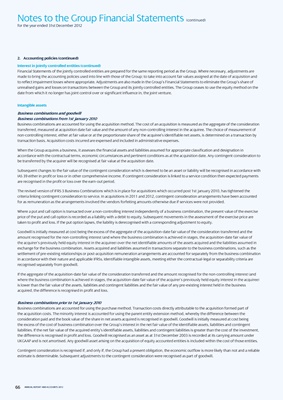
Notes to the Group Financial Statements (continued)
for the year ended 31st December 2012
2. Accounting policies (continued)
interest in jointly controlled entities (continued)
Financial Statements of the jointly controlled entities are prepared for the same reporting period as the Group. Where necessary, adjustments are
made to bring the accounting policies used into line with those of the Group; to take into account fair values assigned at the date of acquisition and
to reflect impairment losses where appropriate. Adjustments are also made in the Group’s Financial Statements to eliminate the Group’s share of
unrealised gains and losses on transactions between the Group and its jointly controlled entities. The Group ceases to use the equity method on the
date from which it no longer has joint control over or significant influence in, the joint venture.
intangible assets
Business combinations and goodwill
Business combinations from 1st January 2010
Business combinations are accounted for using the acquisition method. The cost of an acquisition is measured as the aggregate of the consideration
transferred, measured at acquisition date fair value and the amount of any non-controlling interest in the acquiree. The choice of measurement of
non-controlling interest, either at fair value or at the proportionate share of the acquiree’s identifiable net assets, is determined on a transaction by
transaction basis. Acquisition costs incurred are expensed and included in administrative expenses.
When the Group acquires a business, it assesses the financial assets and liabilities assumed for appropriate classification and designation in
accordance with the contractual terms, economic circumstances and pertinent conditions as at the acquisition date. Any contingent consideration to
be transferred by the acquirer will be recognised at fair value at the acquisition date.
Subsequent changes to the fair value of the contingent consideration which is deemed to be an asset or liability will be recognised in accordance with
IAS 39 either in profit or loss or in other comprehensive income. If contingent consideration is linked to a service condition then expected payments
are recognised in the profit or loss over the earn-out period.
The revised version of IFRS 3 Business Combinations which is in place for acquisitions which occurred post 1st January 2010, has tightened the
criteria linking contingent consideration to service. In acquisitions in 2011 and 2012, contingent consideration arrangements have been accounted
for as remuneration as the arrangements involved the vendors forfeiting amounts otherwise due if services were not provided.
Where a put and call option is transacted over a non-controlling interest independently of a business combination, the present value of the exercise
price of the put and call option is recorded as a liability with a debit to equity. Subsequent movements in the assessment of the exercise price are
taken to profit and loss. If the put option lapses, the liability is derecognised with a corresponding adjustment to equity.
Goodwill is initially measured at cost being the excess of the aggregate of the acquisition-date fair value of the consideration transferred and the
amount recognised for the non-controlling interest (and where the business combination is achieved in stages, the acquisition-date fair value of
the acquirer’s previously held equity interest in the acquiree) over the net identifiable amounts of the assets acquired and the liabilities assumed in
exchange for the business combination. Assets acquired and liabilities assumed in transactions separate to the business combinations, such as the
settlement of pre-existing relationships or post-acquisition remuneration arrangements are accounted for separately from the business combination
in accordance with their nature and applicable IFRSs. Identifiable intangible assets, meeting either the contractual-legal or separability criteria are
recognised separately from goodwill.
If the aggregate of the acquisition-date fair value of the consideration transferred and the amount recognised for the non-controlling interest (and
where the business combination is achieved in stages, the acquisition-date fair value of the acquirer’s previously held equity interest in the acquiree)
is lower than the fair value of the assets, liabilities and contingent liabilities and the fair value of any pre-existing interest held in the business
acquired, the difference is recognised in profit and loss.
Business combinations prior to 1st January 2010
Business combinations are accounted for using the purchase method. Transaction costs directly attributable to the acquisition formed part of
the acquisition costs. The minority interest is accounted for using the parent entity extension method, whereby the difference between the
consideration paid and the book value of the share in net assets acquired is recognised in goodwill. Goodwill is initially measured at cost being
the excess of the cost of business combination over the Group’s interest in the net fair value of the identifiable assets, liabilities and contingent
liabilities. If the net fair value of the acquired entity’s identifiable assets, liabilities and contingent liabilities is greater than the cost of the investment,
the difference is recognised in profit and loss. Goodwill recognised as an asset as at 31st December 2003 is recorded at its carrying amount under
UKGAAP and is not amortised. Any goodwill asset arising on the acquisition of equity accounted entities is included within the cost of those entities.
Contingent consideration is recognised if, and only if, the Group had a present obligation, the economic outflow is more likely than not and a reliable
estimate is determinable. Subsequent adjustments to the contingent consideration were recognised as part of goodwill.
66 ANNUAL REPORT AND ACCOUNTS 2012